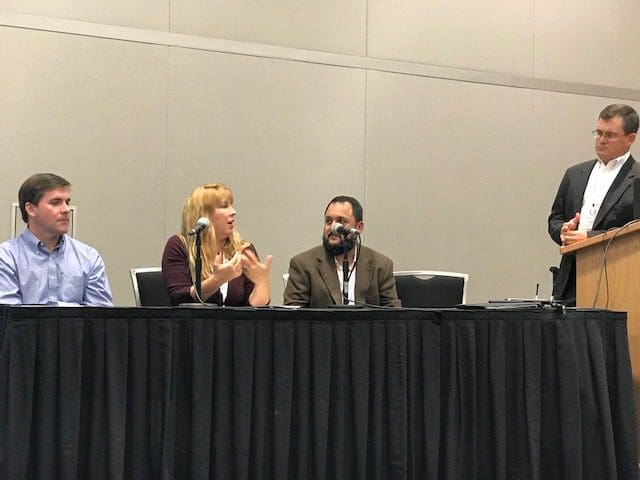How Digital Transformation is Changing the Future Role of the CIO

At a recent INNOTECH Austin Conference, I had the pleasure of moderating a panel discussion titled, “CIO 2020: Positioning Yourself for the Next Shift,” which delved into the changes technology leaders will face in the next few years as digital transformation continues to impact the way that companies of all sizes operate. The three leading executives on our panel brought up remarkably similar issues, despite working for companies in different markets and in three different stages of growth.
I asked our panelists to share their insights about the current and emerging technology challenges they are facing within their organizations, and to tell us how those challenges are changing how their IT and business teams interact.
Here are the key themes and takeaways from our discussion:
We’re all digging out of technical debt
Charles Valentine, Vice President of Technology Services at fast-growing job search company Indeed, started us off by announcing all their departments had recently hit the million-row limit in Microsoft Excel. That hard stop prompted the organization’s current work: getting out of running the business on spreadsheets, and providing the IT tools to democratize the information their people need.
Barbara Daniels, Controller at BuildASign, said that using Excel along with homegrown legacy systems had resulted in the need to constantly “MacGyver” everything, creating inconsistent information across the company. She added that their biggest challenge was digging out of the technical debt created by deploying projects at the expense of building infrastructure. They are now focused on integrating their systems to improve reporting and break down data silos.
Jim Roth, Senior Vice President of Services IT at Dell EMC, pointed to the acquisition of EMC 14 months ago as the company’s biggest integration challenge, and said their technical debt often takes the form of highly customized applications. This well-established enterprise organization is focusing on cleaning up its knowledge data to better serve customers and to pave the way for AI. They are also working to unwind years of customization, so they can better leverage their software partners and R&D to help them innovate at speed and create turnkey technology.
IT is moving from order-taker to innovator
In all three companies, the days of throwing projects over the wall to IT have ended. Instead, IT is taking on a trusted partner role, providing insight and driving more strategic decision-making. Indeed now embeds business intelligence teams within each department to help select technology, automate the business, and generate reports that eliminate manual work.
At BuildASign, the federated IT model puts IT and end users like production, consumer service and marketing at the same meetings, which gives IT the opportunity to share the insights derived from serving all the business users across the company. Jim agreed, adding, “IT has a unique point of view. They see things in the industry, in the data, in the usage of applications, that are really relevant to the business.”
Collaboration leads to transformation
In addition to breaking down data silos, each company is moving to break down the divisions between traditional IT and business roles, enabling teams to learn each other’s languages. We saw one great result of that change right on our panel: a controller who doesn’t talk like a controller. Barbara, who is currently the project administrator for Netsuite on her team, spoke at length not just about finance, but Agile methodology, marketing, eCommerce and SEO.
Indeed takes a similar approach by heaving involving departments in leading efforts like rolling out Salesforce and handling ERP upgrades. Charles said business leaders feel more engaged in the success of the solution as a result. “In my experience, whenever you have opportunity to align power and responsibility, things go better.”
At Dell EMC, they went even further: rotating people between business and IT teams, and then banning the words “IT” and “business” entirely – an idea designed to eliminate the old “us vs. them” mentality and encourage people to build more understanding of one another’s roles. Jim, now 18 months into his own technology rotation, said they had had particular success with a recent Salesforce implementation pilot that put 25 UX, analytics and dev people together in the same room, located where users could come in every day to get lunch and offer constructive feedback.
The collaborative culture that grows out of these team efforts makes it possible to get more done, and to move into the future with a shared understanding of your organization’s underlying business needs. It can also act as a grounding force as you consider everything from AI and machine learning to how to hire and retain the right workforce to take on emerging technologies. And that makes it fitting that the Controller on our panel put it best: “We have to constantly innovate, and if we are not working together, we are not leveraging skill sets and won’t be able to grow.”
Bringing It All Together
The challenges our three panelists shared are by no means unique to their companies. Digital transformation is real and it is happening now. From advanced analytics, automation and cloud-based applications, to business intelligence, digital technologies are rapidly changing the way that companies of all sizes operate and thrive in today’s competitive market. To remain relevant, companies of all sizes must adapt to survive, modernize to meet the needs of consumers and learn how to leverage the latest digital technologies and expertise to their advantage. For CIOs, this means moving beyond just “managing” IT and instead toward helping the organization find its competitive advantage.
If your organization is working to digitally transform your infrastructure, contact us! Our cross-functional team of experts can work with you to integrate business systems, optimize technology landscape and streamline reporting and operations. Learn more about our technology consulting practice here.






